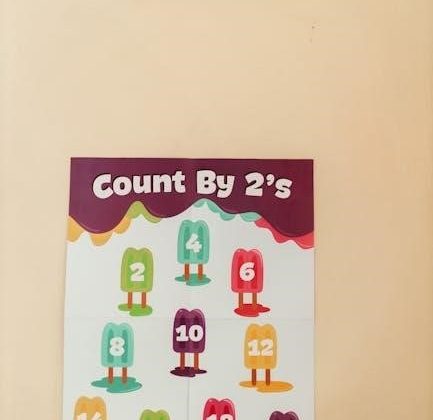quizzes for 10 12 year olds with answers pdf
Quizzes are a valuable resource for engaging young minds, helping children aged 10-12 learn and retain information effectively. Designed to be fun and educational, they cover various subjects, making learning interactive and enjoyable while providing accessible answers in PDF format for easy reference and self-assessment.
What Are Quizzes for 10-12 Year Olds?
Quizzes for 10-12 year olds are engaging educational tools designed to test knowledge and promote learning in a fun, interactive way. They cover subjects like math, science, and English, with answers provided in PDF format for easy access. These quizzes cater to young learners’ curiosity, fostering problem-solving skills and critical thinking while keeping them interested and motivated to learn more about the world around them.
Why Use Quizzes with Answers in PDF Format?
Quizzes with answers in PDF format provide convenience and accessibility, allowing easy access offline and across devices. They maintain consistent formatting, making them ideal for printing or digital use; Interactive features like fill-in-the-blanks and multiple-choice questions engage young learners. This format supports independent learning and helps track progress effectively while keeping the content clear and organized.
Why Quizzes Are Important for This Age Group
Quizzes challenge young minds, fostering critical thinking and problem-solving skills. They make learning enjoyable while reinforcing knowledge retention and skill development, essential for academic growth and confidence building.
Cognitive Development
Quizzes for 10-12 year olds play a key role in enhancing cognitive development by boosting memory, problem-solving skills, and logical thinking. They stimulate critical thinking, encouraging children to analyze information and make connections between concepts. Regular quiz participation sharpens focus and improves mental organization, laying a strong foundation for future academic success and intellectual growth.
Enhanced Learning Experience
Quizzes for 10-12 year olds with answers in PDF format create an engaging and interactive learning environment. They make complex concepts fun and accessible, encouraging active participation. By incorporating visual and hands-on activities, quizzes cater to different learning styles, fostering a deeper understanding of subjects. This approach builds confidence and motivates children to explore new topics with enthusiasm and curiosity. Regular use enhances overall academic engagement and enjoyment.

How to Create Effective Quizzes
Design quizzes aligned with curriculum goals, ensuring clarity and age-appropriateness. Incorporate varied question types, clear instructions, and structured feedback to maximize engagement and learning outcomes effectively.
Planning the Quiz Structure
Start by defining clear objectives and outlining the quiz sections. Include a mix of question types to cater to different learning styles. Organize questions from simple to complex to gradually challenge students. Ensure timing aligns with attention spans, typically 30-45 minutes for this age group. Provide clear instructions and include an answer key for easy grading and feedback. This structure promotes focus and effective learning.
Types of Questions
Use a variety of question types to keep quizzes engaging. Multiple choice questions are great for testing recognition of facts. True or false questions can assess understanding of concepts. Fill-in-the-blanks encourage active recall, while short answer questions allow students to express their knowledge in their own words. This mix caters to different learning styles and keeps young minds interested and motivated during the quiz.
Including Answer Keys
Including answer keys in quizzes is essential for immediate feedback and self-assessment. They help students identify mistakes and learn from them. Answer keys also save educators time, ensuring accurate grading. Providing them in PDF format makes it easy for parents and teachers to access and use the quizzes without additional preparation. This feature enhances the learning experience and promotes accountability.
Popular Subjects for Quizzes
- Math: Basic algebra and geometry problems.
- Science: Biology, chemistry, and physics concepts.
- English: Grammar, reading comprehension, and vocabulary.
- History: World history and cultural studies.
These subjects are foundational for this age group, ensuring well-rounded knowledge and skill development through engaging quizzes.
Math
Math quizzes for 10-12 year olds often focus on foundational concepts like basic algebra, geometry, and arithmetic. Problems may include solving equations, calculating areas, and understanding fractions. Word problems and mental math exercises are also common, helping students apply math to real-life situations; These quizzes are designed to build confidence and fluency in mathematical reasoning. PDF formats make it easy for parents and educators to access and print these resources, ensuring consistent practice and skill development.
- Basic algebra: Solving simple equations and graphing lines.
- Geometry: Understanding shapes, angles, and basic measurements.
- Word problems: Applying math to everyday scenarios.
- Mental math exercises: Improving calculation speed and accuracy.
These quizzes support learning by reinforcing key math skills in an engaging and structured way.
Science
Science quizzes for 10-12 year olds cover biology, chemistry, and physics basics. Topics include cells, ecosystems, simple chemical reactions, and forces. Interactive questions like multiple-choice and true/false help reinforce concepts. PDF formats with answers make it easy for kids to test their knowledge and for educators to track progress. These quizzes foster curiosity and improve understanding of the natural world.
- Biology: Cells, plants, and animal life cycles.
- Chemistry: Basic elements and reactions.
- Physics: Motion, energy, and simple machines.
Quizzes in PDFs are a great way to engage young learners and encourage STEM interest.
English
English quizzes for 10-12 year olds focus on grammar, vocabulary, reading comprehension, and basic literature. PDFs with answers provide interactive learning tools, helping kids improve communication skills. Topics include sentence structure, word meanings, and comprehension passages. Quizzes also cover spelling and punctuation, making them ideal for self-assessment and classroom use. They are engaging and help build confidence in language skills.
- Grammar and sentence structure.
- Vocabulary building.
- Reading comprehension exercises.
History
History quizzes for 10-12 year olds explore key events, cultural practices, and historical figures. PDFs with answers make learning engaging and accessible. Topics include ancient civilizations, world wars, and regional histories. Quizzes help develop critical thinking and chronological understanding, fostering a deeper appreciation for the past and its impact on the present.
- Key historical events and timelines.
- Cultural practices and traditions.
- Notable figures and their contributions.

Quiz Formats
Popular quiz formats include multiple choice, true/false, and fill-in-the-blanks. These formats engage kids, cater to different learning styles, and are easy to create in PDFs for convenience.
Multiple Choice
Multiple choice quizzes are engaging and effective for 10-12 year olds. Each question offers 3-5 options, with one correct answer. This format reduces guessing errors and makes grading easier. It also caters to different learning styles, promoting critical thinking and problem-solving skills. PDFs provide clear layouts, enhancing readability and convenience for both kids and educators. This format is ideal for assessing a wide range of subjects and topics.
True or False
True or False questions are simple yet effective for young learners. They present clear statements, requiring students to identify them as correct or incorrect. This format enhances quick decision-making and fact recall. PDFs organize these questions neatly, making them easy to read and answer. True or False quizzes are great for assessing understanding in various subjects, from science facts to historical events, in a straightforward manner.
Fill-in-the-Blanks
Fill-in-the-Blanks questions are excellent for improving vocabulary and reinforcing key concepts. Students complete sentences by filling in missing words, which helps strengthen memory and understanding. PDF formats make it easy to create and distribute these quizzes, ensuring clarity and organization. This interactive style encourages active participation and critical thinking, making learning engaging for young minds while assessing their grasp of essential topics effectively.
Benefits of Using Quizzes
Quizzes enhance learning by boosting knowledge retention and encouraging active participation. They help students identify strengths and weaknesses, fostering a deeper understanding of subjects while building confidence and problem-solving skills in an engaging and interactive way;

Knowledge Retention
Quizzes significantly improve knowledge retention by reinforcing learning through active recall. Regular practice helps students remember facts and concepts more effectively, as it strengthens memory connections. Immediate feedback from quizzes allows children to correct mistakes and understand where they need to focus. This repetitive engagement with material ensures long-term retention and better academic performance over time.
Skill Development
Quizzes foster essential skills like critical thinking and problem-solving, encouraging children to analyze information and make informed decisions. They enhance time management and accuracy, as kids learn to complete tasks efficiently. Regular quizzes also improve attention to detail and boost confidence, helping students feel more capable and prepared for future challenges.

Where to Find Quizzes
Discover educational websites, teacher resources, and community forums offering free PDF quizzes for kids aged 10-12. These platforms provide a variety of subjects and difficulty levels.
Educational Websites
Reputable educational websites like Kahoot, Quizlet, and Education.com offer a wide range of quizzes for 10-12 year olds with answers in PDF format. These platforms provide interactive and printable resources, covering subjects like math, science, and English. They cater to different learning styles and are designed to be both educational and engaging for young learners.
Teacher Resources
Teacher resource platforms like Teachers Pay Teachers and Tes Resources offer diverse quiz materials for 10-12 year olds with answers in PDF format. These sites provide ready-to-use worksheets, study guides, and interactive activities tailored to various subjects. Educators can access a wealth of customizable content to create engaging and effective assessments for their students, supporting both individual and classroom learning needs.
Community Forums
Community forums are invaluable platforms where educators and parents collaborate, sharing quizzes for 10-12 year olds with answers in PDF format. These forums foster a sense of shared learning, allowing users to exchange resources and ideas. They also provide opportunities for discussion on curriculum alignment and innovative teaching methods, making them a rich source for educational materials and support.
Tools for Creating Quizzes
Utilize online platforms like Kahoot and Quizlet, or software like Google Forms and PowerPoint, to design engaging quizzes with answer keys. These tools offer templates, customization, and easy PDF exports, making quiz creation efficient and accessible for educators and parents.
Online Platforms
Popular online platforms like Kahoot, Quizizz, and Quizlet offer user-friendly interfaces for creating interactive quizzes. These tools provide customizable templates, question banks, and scoring systems. Educators can design quizzes tailored to 10-12 year olds, ensuring engagement and learning. Many platforms allow exporting quizzes with answer keys in PDF format, making it easy to share and print materials for classroom or home use.
Software Applications
Software like Adobe Acrobat, Microsoft Office, and specialized quiz makers offer robust tools to design quizzes. These applications provide features like templates, question design, and PDF export options. Educators can create visually appealing, age-appropriate quizzes with answer keys. These tools ensure professional formatting and easy sharing, making them ideal for producing high-quality, printable materials tailored to 10-12 year olds.

Engaging Kids with Quizzes
Interactive quizzes with visually appealing designs and relatable topics keep kids motivated. Including answer keys in PDFs allows self-assessment, fostering independence and a love for learning through fun challenges.
Making It Fun
Incorporate colorful graphics, humor, and relatable themes to captivate young learners. Gamify quizzes with rewards or timers to boost excitement. Use interactive formats like puzzles or riddles to make learning feel like play. Ensure the PDF layout is visually appealing, with clear sections and engaging fonts. This approach fosters a positive attitude toward quizzes and makes the learning process enjoyable and dynamic for 10–12-year-olds.
Group Activities

Organize quizzes in teams to foster collaboration and teamwork. Divide students into small groups to solve questions together, encouraging peer discussion and problem-solving. Group activities promote social interaction and shared learning experiences. Use PDF quizzes as a resource for team challenges, ensuring everyone has access to the same material. This cooperative approach helps build confidence and makes learning a collective, enjoyable experience for 10–12-year-olds.

Cultural and General Knowledge
Cultural and general knowledge quizzes help students explore diverse topics like geography, history, and current events, fostering a well-rounded understanding of the world and its many facets.
Geography
Geography quizzes introduce kids to diverse countries, cultures, and maps, sparking curiosity about the world. They cover continents, capitals, and landforms, enhancing spatial awareness and global understanding. Interactive questions make learning fun, while answers in PDF format provide clarity. These quizzes also help develop map-reading skills and foster an appreciation for cultural diversity, encouraging kids to explore and collaborate on group activities.
Current Events
Current events quizzes keep kids informed about global happenings, fostering awareness of news, trends, and cultural shifts. They cover science breakthroughs, environmental issues, and historical milestones, making learning dynamic and relevant. PDF quizzes with answers provide clear guidance, helping young learners stay engaged and develop critical thinking about the world around them, while encouraging discussion and participation in group activities.

Tips for Parents and Educators
Current events quizzes engage kids with global news, science, and culture, fostering awareness and critical thinking. PDF formats make these quizzes accessible and easy to use, ensuring young learners stay informed about the world while developing essential skills through interactive and educational activities that promote discussion and participation in group settings.
Encouraging Participation
Encourage kids to participate in quizzes by making them interactive and fun. Use positive reinforcement, like praise or small rewards, to boost confidence. Ensure quizzes are relevant to their interests to spark curiosity. Create a supportive environment where mistakes are seen as learning opportunities. Providing clear instructions and allowing time for reflection can also motivate them to engage actively with the material.
Providing Feedback
Providing constructive feedback after quizzes helps children understand their strengths and areas for improvement. Highlight correct answers and explain reasoning behind them. For incorrect responses, guide them to the right solutions without discouraging them. Encourage self-assessment to foster a growth mindset. Timely and specific feedback enhances learning outcomes and builds confidence in young learners, helping them progress effectively.

The Role of PDF Formats
PDF formats provide versatility and accessibility for quizzes, making them ideal for offline use, easy sharing, and printing. They ensure consistent formatting and readability across devices, benefiting both educators and students.
Convenience
PDF formats offer unmatched convenience for quizzes, allowing easy access offline, simple printing, and seamless sharing via email or cloud platforms. They eliminate the need for internet connectivity, making them ideal for classrooms or home use. Teachers and parents can quickly distribute and print PDFs, saving time and effort. This format ensures quizzes are readily available whenever needed, promoting efficient learning and organization.
Accessibility
PDFs ensure quizzes are accessible to all users, regardless of device or platform, making them ideal for diverse learning environments. They can be easily viewed on computers, tablets, and smartphones without requiring specific software. This universal compatibility ensures that 10-12 year olds can access quizzes anywhere, promoting inclusivity and equal learning opportunities for every student.
Quizzes for 10-12 year olds with answers in PDF format are a valuable educational tool, fostering skill development and confidence while ensuring accessibility and consistency in learning.
Final Thoughts
Quizzes for 10-12 year olds with answers in PDF format provide an engaging way to reinforce learning and assess understanding. They cater to various subjects, ensuring well-rounded development. Parents and educators can easily access and print these resources, making them a convenient tool for fostering academic growth. Regular use of quizzes helps build confidence and a strong foundation for future success, encouraging a lifelong love for learning in young minds.
Next Steps
Start by exploring educational websites and teacher resources for age-appropriate quizzes. Encourage children to practice regularly, using PDF answers for self-assessment. Discuss results with educators to identify strengths and areas for improvement. Incorporate quizzes into study routines and reward progress to keep young learners motivated and engaged in their academic journey.










